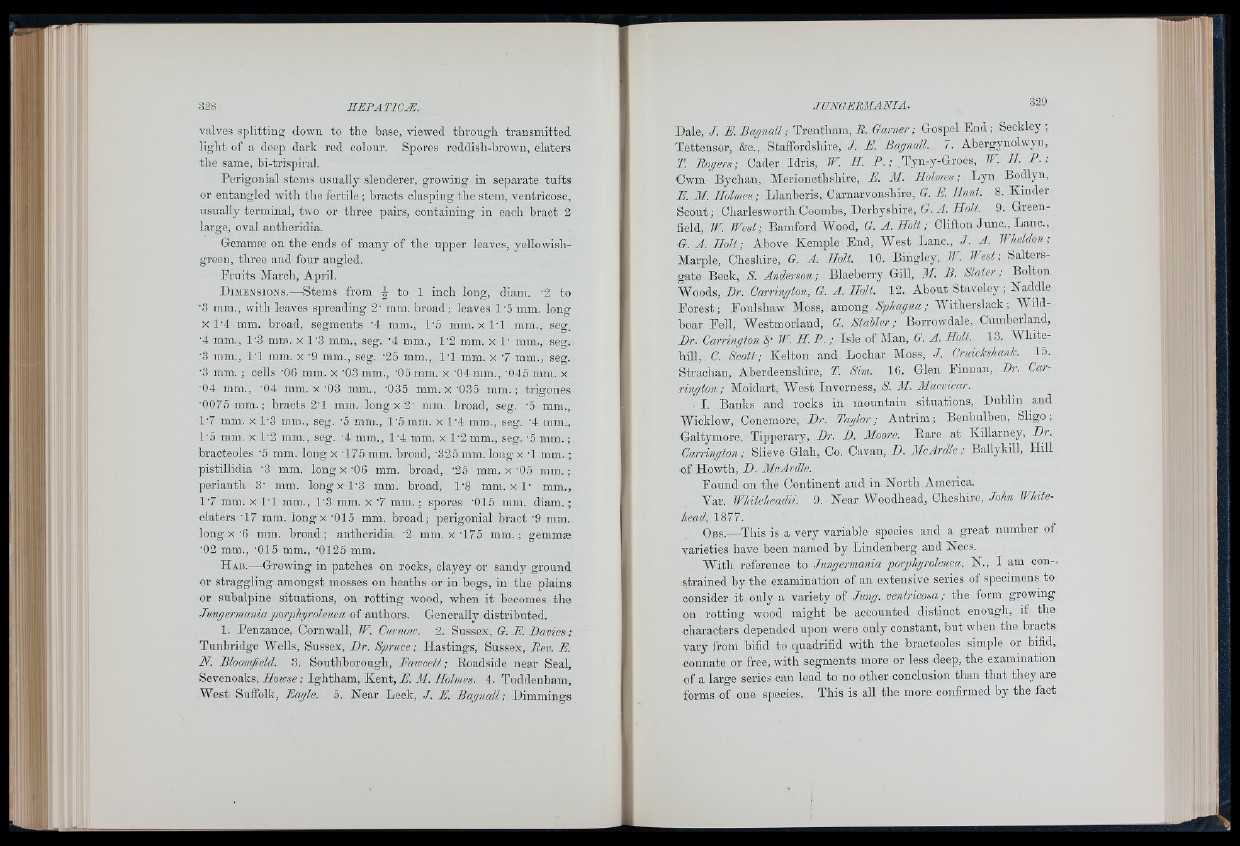
' i
valves splitting down to the base, viewed through transmitted
light of a deep dark red colour. Spores reddish-brown, elaters
tbe same, bi-trispiral.
Perigonial stems usually slenderer, growing in separate tufts
or entangled with the fertile ; bracts clasping the stem, ventricose,
usually terminal, two or tliree pairs, containing in each bract 2
large, oval antheridia.
Gemmæ on the ends of many of the upper leaves, yellowish-
green, three and four angled.
Fruits March, April.
Dimensions.—Stems from -J to 1 inch long, diam. '2 to
•3 mm., with leaves spreading 2' mm. broad ; leaves 1'5 mm. long
X 1-4 mm. broad, segments '4 mm., 1’5 mm. x IT mm., seg.
•4 mm., 1'3 mm. x 1'3 mm., seg. '4 mm., 1'2 mm. x 1’ mm,, seg.
•3 ram., IT ram. x '9 mm., seg. '25 mm., IT mm, x 7 mm., seg.
•3 mm. ; cells 'OG mm. x '03 mm., ’05 mm. x '04 mm., '045 mm. x
■04 mm., -04 mm. x '03 mm., '035 mm. x -085 mm.; trigones
■0075 mm.; bracts 2'1 mm. long x 2' mm, broad, seg. -5 mm.,
1'7 mm. x 1-3 rnm., seg. '5 mm., I ’Smm. x 1'4 mm,, seg. '4 mrn.,
1'5 mm. X 1'2 mm., seg. '4 mm., 1'4 mm. x 1'2 mm., seg. '5 mm. ;
bracteoles '5 mm. long x '175 mm. broad, '325 mm. long x '1 mm. ;
pistillidia '3 mm. long x 'OG mm. broad, ’25 mm. x '05 mm. ;
perianth 3' mm. lo n g x l'3 mm. broad, 1‘8 mm. x 1- mm.,
1'7 mm. x I 'l rnm,, 1'3 mm. x '7 mm. ; spores ’015 mm. diam. ;
elaters '17 mm. long x ’015 mm. broad; perigonial bract '9 mm.
long X ’6 mm. broad; antheridia '2 mm. x ‘175 mm.; gemmæ
■02 mm., '015 mm., '0125 mm,
H a b .—Growing in patches on rocks, clayey or sandy ground
or straggling amongst mosses on heaths or in bogs, iir the plains
or subalpine situations, on rotting wood, when it becomes the
Junyermania porjjhyroleuca of authors. Generally distributed.
1. Penzance, Cornwall, W. Curnow. 2. Sussex, G.E. Bavies;
Tunbridge Wells, Sussex, Dr. Spruce; Hastings, Sussex, Bev. E.
N. Bloomfield. 3. Southborough, Eaiocett ; Eoadside near Seal,
Sevenoaks, Howse; Ightham, K en t,/'. M. Holmes. 4. Tuddenham,
West Suffolk, Eayle. 5. Near Leek, J. E. Bagnall; Dimmings
Dale. J. E. Bagnall; Trentham, H. Garner; Gospel End; Seckley;
Tettensor, &c., Staffordshire, J. E. Bagnall. 7. Abergynolwyn,
T. Rogers; Cader Idris, W. H. P .; Tyn-y-Groes, W. H. P .;
Cwm Bychan, Merionethshire, E. M. Holmes; Lyn Bodlyn,
E. M. liolmes; Llanberis, Carnarvonshire, G. E. Hunt. 8. Kinder
Scout; Charlesworth Coombs, Derbyshire, G. A. Holt. 9. Greenfield,
JF. JFesl; Bamford AVood, G. A. Holt; Clifton Juno., Lane.,
G. A. Holt; Above Kemple End, West Lane., J. A. Wheldon;
Marple, Chesliire, G. A. Holt. 10. Bingley, IF. JJfst; Saltersgate
Beck, S. Anderson; Blaeberry Gill, M. B. Slater; Bolton
Woods, Br. Carrington, G. A. Holt. 12. About Staveley; Naddle
Eorest; Foulshaw Moss, among Sphagna; AVitherslaok; Wild-
boar Fell, Westmorland, G. Stabler: Borrowdale, Cumberland,
Br. Carrington fl JF H. P . ; Isle of Alan, G. A. Holt. 13. White-
hill, C. Scott; Kelton and Lochar AIoss, J. Cruichshanl. 15.
Strachan, Aberdeenshire, T. Sim. 16. Glen Finnan, Br. Carrington;
Moidart, West Inverness, S. M. Macvicar.
I. Banks and rooks in mountain situations, Dublin and
Wicklow, Conemore, Dr. Taylor; Antrim; Benbulben, Sligo;
Galtymore, Tipperary, Dr. D. Moore. Eare at Killarney, Dr.
Carrington; Slieve Glah, Co. Cavan, D. McArdle; Ballykill, Hill
of Howth, D. McArdle.
Found on the Continent and in North America.
Var. Whiteheadii. 9. Near Woodhead, Cheshire, John JVhite-
head, 1877.
O b s .—This is a very variable species and a great number of
varieties have been named by Lindenherg and Nees.
With reference to Jungermania porphyroleuea, N., I am con-,
strained by the examination of an extensive series of specimens to
consider it only a variety of Jung, ventricosa; the form growing
on rotting wood might be accounted distinct enough, if the
characters depended upon were only constant, but when the bracts
vary from bifid to quadrifid with the bracteoles simple or bifid,
connate or free, with segments more or less deep, the examination
of a large series can lead to no other conclusion than that they are
forms of one species. This is all the more confirmed by the fact
;7i !■
•i' '.i